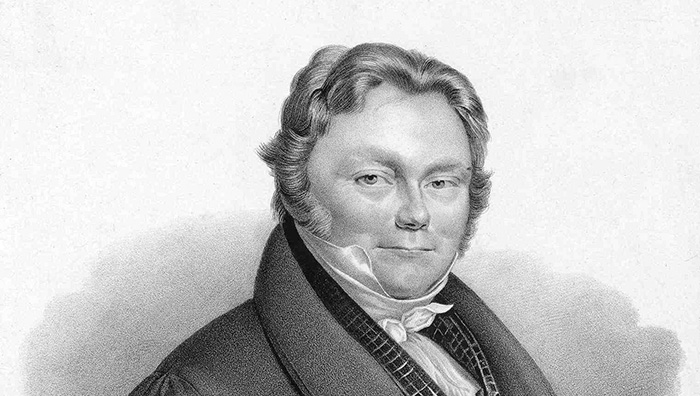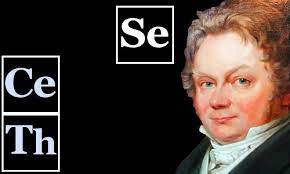If we name elements with symbols, it is because: Who is Jöns Jacob Berzelius?
(1779-1848) Swedish chemist. He determined the atomic weights of many elements, developed the symbolic naming system for elements and the "dualism theory" for inorganic salts.

He was born on 19 August 1779 in Ostergötland, in the town of Vâversunda near Linköping. When he lost his father at the age of four and his mother at the age of nine, he took refuge with his sister with his uncle, but could not find a happy family life. Living in a shelter next to his relatives, the conflict between him and his nephews, and the lack of money made him irritable with life. Berzelius, who failed to be a harmonious student at Linköping High School, which he entered in 1793, left a very negative impression on his teachers while receiving his diploma.

Baron Jöns Jacob Berzelius (20 August 1779 – 7 August 1848) was a Swedish chemist. Berzelius is considered, along with Robert Boyle, John Dalton, and Antoine Lavoisier, to be one of the founders of modern chemistry. Berzelius became a member of the Royal Swedish Academy of Sciences in 1808 and served from 1818 as its principal functionary. He is known in Sweden as the "Father of Swedish Chemistry". Berzelius Day is celebrated on 20 August in honour of him.
After finishing high school, he decided to study medicine and entered Uppsala University in 1796; but his financial resources were very limited. He continued his education with difficulty, first by giving private lessons and receiving a three-year scholarship in 1798. He could not establish good relations with his teachers at university, as he did in his high school years, and he often clashed with them, especially because he found the education level in science very inadequate. That's why Berzelius, one of the greatest famous scholars of chemistry, could hardly get a passing grade in the chemistry final exam. After completing his medical education by passing all his exams in 1802, he started to work as an assistant in medicine and pharmacy at the Medical School of Stockholm University. While he was trying to make a living by working as a doctor in the slums of Stockholm, he spent all his free time on chemistry research.
When the professor of medicine and pharmacy died in 1807, Berzelius was replaced by Berzelius, and after that date, the most productive period began in the life of Berzelius, who concentrated on laboratory research and compiled the first notes of his books. The chemist, who soon established his worth, was elected as a member of the Swedish Academy of Sciences in 1808 and as its president two years later. In the same year, the School of Medicine, where Berzelius was a professor, left Stockholm University and became an autonomous structure under the name of Karolinska Institute. In the following years, Berzelius went to England, Germany, and France and met the most famous chemists of the age, and invited many young chemists to his laboratory in Sweden to work together. Appointed secretary of the Swedish Academy of Sciences in 1818, married late in 1835, received the title of baron from King Charles XIV of Sweden during the ceremony, and died in Stockholm on August 7, 1848.
Berzelius, who owed the point he reached in chemistry to his own efforts rather than education, was trying to learn this science by reading all the books he could find in his country. he knew his work. In his early experiments, however, he realized that oxygen played a very important role in the structure of chemical compounds, and like Lavoisier, he was opposed to the phlogistonists.
Since Sweden in the early 19th century was quite outside of the new chemistry trends that developed in Europe, Berzelius was involuntarily interested in the work of chemists who had previously been trained in Sweden and other Scandinavian countries. One of these issues was finding new unknown elements and minerals. His close friendship with a mining operator named Wilhelm Hisinger, who had a great interest in chemistry and mineralogy, had a great influence on the selection of Berzelius' early works. In 1803, when they started working together, at Hisinger's suggestion, they first engaged in the chemical analysis of various minerals in his mine and separated the hitherto unknown cerium element from an ore. Berzelius, who never lost his interest in mineralogy, discovered selenium and thorium in the following years, lithium, tantalum, vanadium, zirconium, and many other rare earth elements were found in his laboratory by his students working under his supervision.
Indeed, it was Berzelius who developed the chemical analysis of minerals with new methods and took them far beyond where they were. In 1814, he suggested for the first time a classification based on chemical structure, emphasizing that it was very wrong to classify minerals according to their external appearance or physical properties, as has been done until that day. This classification, which was initially met with opposition, was later adopted by mineralogy scholars, and Berzelius, who explained that silicon dioxide was in acid form, gave mineralogy a large group of minerals known as silicates.
One of the fields that Berzelius was interested in during his early working years was electrochemistry. The long electrolysis experiments that He and Hisinger conducted to examine the effects of electric current on various sodium, calcium, and potassium salts were also the basis for Berzelius' famous "dualistic" theory in 1803. In these studies, they showed that during electrolysis each salt decomposes into its constituent acids and bases. , they observed that bases collect at the negative pole and acids at the positive pole. Based on the opinion of Lavoisier, who suggested that oxygen is one of the basic components not only of all acids, but also of bases, and his own experimental findings, Berzelius defined bases as electropositive oxides and acids as electronegative oxides. He developed the "dualism theory", which argues that salts are composed of positive and negative components and that these two oppositely charged components can stay together by neutralizing each other.
He suggested that in the formula of salts, the acid and base radicals that makeup that salt should be specified separately. He also evaluated the results of electrolysis of all metal salts, taking oxygen as the element with the highest electronegativity, and ranking all other elements between negative oxygen and positive potassium. With this theory, Berzelius believed he had solved the problem of chemical affinity that troubled his contemporaries, and provided a coherent account of the force that pulls elements or roots together. However, the dualism theory, which continued to be effective for a long time after the 1820s and played an important role in explaining the stability of inorganic compounds, lost its validity and began to collapse when applied to organic compounds. Especially in 1834, Dumas and Laurent's declaration that the chlorine atom replaces the hydrogen atom in some organic compounds and that it does not affect the chemical properties of the compound, completely demolished this theory. Berzelius, who has always been known to be conservative, and who, as he got older, did not adopt any innovations contrary to his own knowledge, did not believe in the results of this experiment. It was so impossible for the electronegative chlorine atom to replace the electropositive hydrogen atom. Not only did he disagree with this argument, which did not fit his theory, but in 1838 he criticized Dumas so fiercely that even Dumas was eventually forced to deny his experimental findings.
Dalton, who started a new era in chemistry with his atomic theory at the beginning of the 19th century, accepted the weight of the hydrogen atom as the basic unit and determined the atomic weights of all other elements according to hydrogen. Believing that all chemical events revolve around the oxygen atom, Berzelius attempted to determine the atomic weights of the elements based on the oxygen atom instead of hydrogen. When he started working, his laboratory was very primitive and inadequately equipped; however, the results obtained with accurate and sensitive analysis methods, which are its strongest points, are not much different from the values accepted today.
The table he published in 1818 accepted the atomic weight of oxygen as 100 and included the relative atomic weights of 45 of the 49 elements known at that time and the element ratios of hundreds of inorganic compounds. While working on so many elements and compounds, he began to look for ways to briefly write down the formulas of chemical reactions and compounds. The current system at that time was Dalton's proposal, and the elements were represented by circles with various signs attached to them.
Seeing that these signs were extremely useless in the writing of compound formulas, Berzelius prepared the birth of an international language of chemistry by proposing the element symbols known today.
Berzelius, who was offended by the gradual development of organic chemistry under the leadership of young chemists and pushing inorganic chemistry, which he valued so much, into the background, was not interested in organic chemistry at all. However, during his years as a medical assistant, he examined many physiological substances such as blood, bone, milk, fat, and cell membranes, and detected the presence of iron in blood and lactic acid in muscle cells. This work later shed light on one of the most important issues in chemistry, the phenomenon of isomerism. Berzelius observed that although the lactic acid in muscle cells and the lactic acid in sour milk have the same composition, their properties are different and they affect polarized light in the opposite direction. The fact that the formulas of cyanic acid analyzed by Wöhler in 1823 and fulminic acid analyzed by Liebig in 1824 were the same (HNCO) led Berzelius to this subject again. Berzelius, who called this phenomenon "isomerism" in 1927, explained that atoms can come together in different ways in some compounds, and foreshadowed the theories of spatial structure and structure analysis that would develop in the future.
Berzelius was the first to use the term "catalysis" in chemistry. In 1835, he deduced from the experiments of chemists, especially Kirenhoff and Davy, that some factors in the environment facilitate reactions and suggested that unknown catalytic forces play a role in such processes.
Despite being criticized from time to time for his scientific conservatism that is not open to new ideas and developments, Berzelius is one of the greatest chemistry systematists who brought the knowledge of previous centuries and his age into a logical whole. Most of his works were translated into German by Wöhler, who was his student and lifelong friend for about a year.
